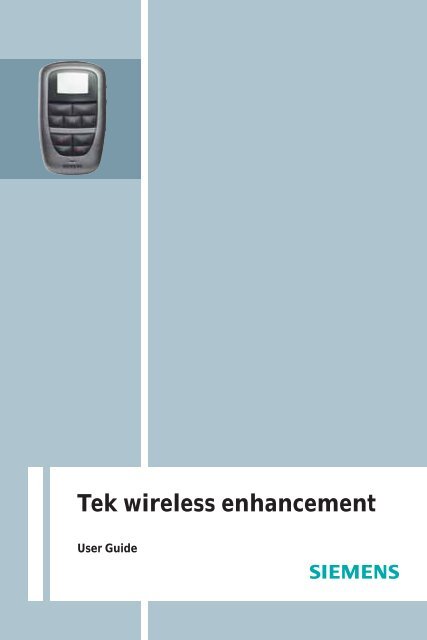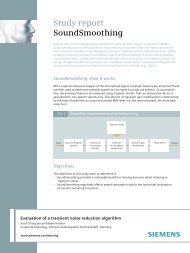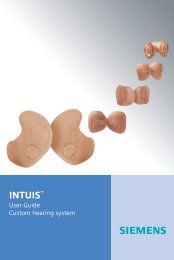Tek user guide - Siemens Hearing Instruments
Tek user guide - Siemens Hearing Instruments
Tek user guide - Siemens Hearing Instruments
You also want an ePaper? Increase the reach of your titles
YUMPU automatically turns print PDFs into web optimized ePapers that Google loves.
1<br />
<strong>Tek</strong> wireless enhancement<br />
User Guide
Introduction<br />
Dear Customer,<br />
Your hearing instruments equipped with e2e wire-<br />
less TM 2.0 technology can be controlled by your new <strong>Tek</strong><br />
Connect remote control.<br />
This remote control offers you more hearing comfort in<br />
your standard life situations. Via Bluetooth it links your<br />
hearing instruments to the expanding world of electron-<br />
ic media. It will support you when you watch television,<br />
listen to music or talk on the phone.<br />
These instructions, together with the guidance from<br />
your <strong>Hearing</strong> Care Professional, will help you to under-<br />
stand how your remote control works.<br />
If you have further questions, please contact your Hear-<br />
ing Care Professional.<br />
1<br />
3
4<br />
12 A Contents<br />
3<br />
4<br />
5<br />
6<br />
7<br />
8<br />
9<br />
<strong>Tek</strong> upgrade 6<br />
- Included in delivery<br />
6<br />
Intended use 8<br />
General notes on safety 9<br />
Safety notes for batteries 11<br />
Getting started 12<br />
- Before first use 12<br />
- Charging process 12<br />
- Running time of the rechargeable battery 12<br />
- Wearing the remote control 14<br />
Basic functions 15<br />
- Key lock 15<br />
- Changing the hearing program 15<br />
- Changing the volume 16<br />
- Changing the SoundBalance (Treble) 16<br />
- Read out the hearing instrument's<br />
information 16<br />
- Turning the hearing instruments on/off 17<br />
- Turning the remote control on/off 17<br />
- Symbols 18<br />
What is Bluetooth? 19
A<br />
10 Using the remote control with a phone 20<br />
- Pairing remote control and phone 20<br />
- Connecting remote control and phone 22<br />
- Headset and hands-free 23<br />
- Making a call 25<br />
- Shifting an existing call from/ to the<br />
remote control 25<br />
11<br />
12<br />
Using the <strong>Tek</strong> Transmitter 26<br />
- Turning the <strong>Tek</strong> Transmitter on/off 26<br />
- Sound level 27<br />
- Charging the <strong>Tek</strong> Transmitter 27<br />
- Connecting the <strong>Tek</strong> Transmitter with an<br />
external device 28<br />
- Receiving the audio stream from an external<br />
device 30<br />
- Receiving a phone call while watching TV 31<br />
Using the direct audio input 32<br />
- Connecting directly to your mp3 player 32<br />
- Receiving a phone call while using the direct<br />
audio input 33<br />
13 Maintenance and care 34<br />
14 Technical information 35<br />
15 Disposal informatio 37<br />
12<br />
5
6<br />
3<br />
<strong>Tek</strong> upgrade<br />
Included in delivery<br />
Device and accessories:<br />
<strong>Tek</strong><br />
connect remote control with rechargeable battery and<br />
lanyard<br />
1 Display<br />
2 Program buttons<br />
3 Volume buttons<br />
4 Telephone buttons<br />
remote control on/off<br />
5 Microphone opening<br />
6 Key lock<br />
7 Read out button<br />
hearing instruments on/off<br />
8 SoundBalance buttons<br />
9 2.5mm stereo socket<br />
10 Socket for power plug<br />
<br />
<strong>Tek</strong> Transmitter<br />
11 On/Off switch<br />
12 Soundlevel<br />
13 Socket for power plug<br />
14 2.5mm stereo socket<br />
15 LED<br />
1<br />
6<br />
2<br />
3<br />
4<br />
5<br />
11<br />
15<br />
12<br />
10<br />
13<br />
7<br />
8<br />
14<br />
9
<strong>Tek</strong> upgrade<br />
<br />
2 Power plugs with country specific adapters<br />
(one for remote control, one for <strong>Tek</strong> Transmitter)<br />
Cables:<br />
1.8 m audio cable with 3.5mm stereo<br />
plug on one side and a 2.5 mm stereo<br />
plug on the other side<br />
0.3 m audio cable with 3.5mm stereo<br />
plug on one side and a 2.5 mm stereo<br />
plug on the other side<br />
Adapter set:<br />
2.5 stereo plug to 3.5 stereo socket<br />
6.3 stereo plug to 3.5 stereo socket<br />
RCA (cinch) to 3.5 stereo socket<br />
RCA (cinch) to SCART<br />
3<br />
7
8<br />
4<br />
Intended use<br />
The <strong>Tek</strong> wireless enhancement is intended to operate<br />
hearing instruments.<br />
Read and follow the instructions of this <strong>user</strong> <strong>guide</strong> to<br />
avoid injuries or damage to the remote control.<br />
Symbols:<br />
Be aware of information marked with the warning symbol<br />
WARNING, CAUTION or NOTICE!<br />
WARNING points out a situation that could<br />
lead to serious injuries.<br />
CAUTION indicates a situation that could lead<br />
to minor and moderate injuries.<br />
NOTICE<br />
NOTICE indicates possible property<br />
damage.<br />
Advice and tips on how to handle your<br />
hearing instrument better.<br />
Instruction. Indicates that something has to be<br />
done.
General notes on safety<br />
WARNING<br />
Wireless systems may interfere with measuring devices<br />
and electronic equipment.<br />
Turn<br />
the remote control off when in hospitals or airplanes.<br />
Prior<br />
to use in conjunction with an electronic implant<br />
or life supporting system, have the electromagnetic<br />
compatibility verified.<br />
NOTICE<br />
Your remote control is sensitive to extreme heat, high<br />
humidity, strong magnetic fields (> 0.1T), X-rays and mechanical<br />
stress.<br />
Do<br />
not expose your remote control to extreme temperature<br />
or high humidity.<br />
Do<br />
not leave it in direct sunlight.<br />
Do<br />
not immerse it in water.<br />
In some countries restrictions for the usage of wireless<br />
equipment exist.<br />
Refer<br />
to local authorities for further information.<br />
The function of the wireless link might be affected<br />
by a nearby electro-magnetic field, such as computer<br />
monitors.<br />
Keep<br />
an appropriate distance from the source of interference<br />
if you experience difficulty.<br />
5<br />
9
10<br />
5<br />
General notes on safety<br />
In<br />
case the hearing instrument is controlled by another<br />
person’s remote control, return to your <strong>Hearing</strong><br />
Care Professional with your remote control and hearing<br />
instruments.<br />
WARNING<br />
Risk of interference with cardiac pacemakers.<br />
Do<br />
not use the remote control if you are fitted with a<br />
cardiac pacemaker.<br />
WARNING<br />
Risk in explosive environments, e.g. mining areas!<br />
Do<br />
not use your hearing instruments (and remote control)<br />
in areas where there is a danger of explosions.<br />
WARNING<br />
Strangulation hazard when lanyard gets entangled in<br />
e.g. moving mechanical parts of machines.<br />
Use<br />
only the delivered breakaway lanyard. It will<br />
automatically detach when entangled.
Safety notes for batteries<br />
WARNING<br />
Risk of explosion when the rechargeable battery is<br />
handled wrong.<br />
Do<br />
not short circuit, pierce, crush or disassemble the<br />
rechargeable battery.<br />
Do<br />
not place in oven or fire.<br />
Do<br />
not immerse in water.<br />
Charge<br />
the rechargeable battery between 0ºC and 45ºC<br />
Remove<br />
the rechargeable battery when the instrument<br />
is not in use for a prolonged period of time.<br />
Do<br />
not throw used batteries into household trash.<br />
Return them to your <strong>Hearing</strong> Care Professional for<br />
environmentally correct disposal.<br />
WARNING<br />
Choking hazard posed by small parts.<br />
Keep<br />
batteries, small parts and remote control out of<br />
children‘s reach.<br />
If<br />
swallowed consult a physician or hospital immediately.<br />
6<br />
11
12<br />
7<br />
Getting started<br />
Before first use<br />
Insert<br />
the rechargeable battery into the remote control.<br />
Charge<br />
the rechargeable battery before first use.<br />
Charging process<br />
Connect<br />
the remote control with the<br />
power plug to a power supply.<br />
The charging process starts. Charging<br />
time is about 5 hours depending on<br />
the status of the rechargeable battery.<br />
Charging is complete when the battery<br />
symbol shows a full battery.<br />
Running time of the rechargeable<br />
battery<br />
The running time of the rechargeable battery depends on<br />
the way the remote control is used.<br />
The<br />
function with the highest power consumpting is the<br />
transmission of an audio signal. This function is active<br />
when telephoning or listening to an external device. The<br />
rechargeable battery will last about 5 hours in this case.<br />
When<br />
no transmission of audio signal is active and a<br />
phone is paired, the rechargeable battery will last several<br />
days.<br />
When<br />
no transmission of audio signal is active and no<br />
telephone is paired, the rechargeable battery lasts several<br />
months.
Getting started<br />
Display information<br />
1 <strong>Hearing</strong> program<br />
2 Program description<br />
only available if programmed by your<br />
<strong>Hearing</strong> Care Professional.<br />
3 Battery status of remote control<br />
The remote control will go into a stand-by mode after<br />
a period of inanctivity. In stand-by mode no information<br />
is shown on the display.<br />
Press<br />
any key to turn the remote control back into<br />
working mode to see the information on the display.<br />
1<br />
2<br />
1<br />
3<br />
7<br />
13
14<br />
7<br />
Getting started<br />
Wearing the remote control<br />
To<br />
operate your hearing instruments wear the remote control<br />
within a distance of 1 m (40 in) to the hearing instruments.<br />
You can wear the remote control, for example, in<br />
your pocket.<br />
For<br />
best listening quality when receiving<br />
an audio stream, wear the remote<br />
control with the lanyard around<br />
your neck. This way remote control<br />
and hearing instruments are in the<br />
proper distance and alignment.<br />
You can also set the remote control on<br />
the table in front of you, for example<br />
when watching tv.<br />
For<br />
best listening quality turn the<br />
remote control in the same direction<br />
you are facing.<br />
When<br />
telephoning with the remote<br />
control, hold the remote control in<br />
your hand and speak directly into the<br />
microphone.
Basic functions<br />
Key lock<br />
Your remote control has a key lock on the<br />
left side.<br />
Slide<br />
the control to the bottom to enable<br />
the key lock.<br />
Pressing the buttons will now have no<br />
locked / unlocked<br />
effect.<br />
Slide<br />
the control to the top to disable the key<br />
lock.<br />
Changing the hearing program<br />
The remote control allows you to control up to<br />
5 programs of your hearing instruments.<br />
Your <strong>Hearing</strong> Care Professional will program<br />
the settings in the different programms for<br />
your particular listening needs.<br />
Press<br />
the number of the desired hearing<br />
program.<br />
The remote control shows the number of<br />
the program you are in now.<br />
You hear the acoustic signal for the chosen<br />
program in your hearing instruments.<br />
Your <strong>Hearing</strong> Care Professional can activate or deactivate<br />
acoustic signals in your hearing instruments.<br />
Acoustic signals confirm changes in the settings such<br />
as program, volume or SoundBalance.<br />
8<br />
15
16<br />
8<br />
Basic functions<br />
Changing the volume<br />
Press to increase the volume.<br />
Press to decrease the volume.<br />
T R E B L E<br />
Changing the SoundBalance (Treble)<br />
With the rocker switch on the right side of the<br />
remote control you can change the sound of your<br />
hearing instruments.<br />
Press + (up) to get a more shrill sound.<br />
Press – (down) to get more muffled sound.<br />
Read out the hearing instrument's information<br />
This functions gives you the possibility to view the<br />
current settings like battery status, volume or hearing<br />
program of your hearing instruments.<br />
Hold the remote control close to one of your<br />
hearing instruments (about 10 cm / 4 in).<br />
Press the read out button.<br />
The display of the remote control shows you the<br />
following information:<br />
1 2 3 4 1 <strong>Hearing</strong> program with description<br />
2 Sound control of hearing instruments<br />
3 Volume of hearing instruments<br />
4 Battery status of hearing instruments<br />
left / right
Basic functions<br />
Turning the hearing instruments on/off<br />
Press the read out button for more than 5<br />
seconds to turn your hearing instruments<br />
off.<br />
Press one of the program buttons on the<br />
remote control to turn the hearing instruments<br />
back on.<br />
Turning the remote control on/off<br />
Press for about 5 seconds to turn the remote control<br />
off.<br />
Press for about 5 seconds to turn the remote control<br />
back on.<br />
WARNING<br />
Wireless systems may interfere with measuring devices<br />
and electronic equipment.<br />
Turn<br />
the remote control off when in hospitals or airplanes.<br />
Prior<br />
to use in conjunction with an electronic implant<br />
or life supporting system, have the electromagnetic<br />
compatibility verified.<br />
8<br />
17
18<br />
8<br />
Basic functions<br />
Symbols<br />
or<br />
full<br />
/<br />
empty<br />
charging<br />
/<br />
/<br />
program number<br />
bluetooth connection active<br />
phone connection active<br />
battery status of remote control<br />
volume up / volume down<br />
treble up/ treble down<br />
key lock activated / deactivated<br />
incoming call<br />
active call<br />
hearing instruments off<br />
error<br />
searching bluetooth audio stream /<br />
/ /<br />
bluetooth audio stream activ / direct<br />
audio stream activ<br />
Read-out symbols<br />
Sound balance and volume of hearing<br />
instruments<br />
battery status of left and right hearing<br />
instrument
What is Bluetooth?<br />
Bluetooth is a wireless standard that provides a way to<br />
wirelessly connect devices like cell phones, laptops, headsets<br />
and others.<br />
Over a Bluetooth connection the devices can exchange information<br />
such as data, sound or even control commands.<br />
The range of the Bluetooth connection in the <strong>Tek</strong> Connect<br />
remote control is about 10 m (32 ft). Walls or objects in between<br />
the devices can shorten this distance.<br />
The Bluetooth symbol denotes wether or not a device<br />
is Bluetooth compatible.<br />
The <strong>Tek</strong> Connect remote control can be connected via<br />
Bluetooth to your cell phone or to the <strong>Tek</strong> Transmitter.<br />
Follow the instructions of the following chapters to hear<br />
sound of your cell phone, TV or mp3 player directly in your<br />
hearing instruments.<br />
9<br />
19
10<br />
20<br />
Using the remote control with a phone<br />
The remote control allows you to<br />
use your hearing instruments as a<br />
wireless headset when you are telephoning<br />
with a Bluetooth compatible<br />
phone or cell phone.<br />
Instead of using the telephone<br />
receiver, you speak in your remote<br />
control and listen through your<br />
hearing instruments.<br />
Pairing remote control and phone<br />
Before you can use the remote control with a phone for<br />
the first time you need to pair your phone and the remote<br />
control. The pairing process can be compared with an "introduction"<br />
of phone and remote control. After the pairing<br />
process the phone and remote control "know" each other.<br />
The pairing process does not need to be repeated.<br />
Activate<br />
the Bluetooth function in your phone.<br />
The display of your phone should<br />
show a Bluetooth symbol when the<br />
Bluetooth function is activated.<br />
Press and hold on the remote control<br />
for about 7 seconds.<br />
The remote control changes to pairing mode. You now<br />
have 2 minutes to<br />
finish the pairing process.<br />
Search<br />
in the menu of your phone for other Bluetooth
Using the remote control with a phone<br />
devices.<br />
Your phone should find a device called<br />
"<strong>Tek</strong> Connect". This is the remote control.<br />
Choose<br />
this device to pair phone and remote control.<br />
Your phone should ask you to insert a PIN.<br />
Insert<br />
"0000"<br />
Refer<br />
to the User Guide of your phone for more detailed<br />
information on how to link devices via Bluetooth.<br />
The remote control can only be paired with one phone<br />
at a time.<br />
If you start to pair another phone with the remote control,<br />
the first pairing information will be deleted. The remote<br />
control "forgets" the contact with the first phone.<br />
10<br />
21
10<br />
22<br />
Using the remote control with a phone<br />
Connecting remote control and phone<br />
After pairing, the phone and remote control "know"<br />
each other. In order to listen to a call through your hearing<br />
instruments it is also necessary to connect the remote<br />
control to your phone. After connecting, the phone and<br />
remote control can "communicate" with each other.<br />
It is not necessary to have the remote control and the<br />
phone connected all the time. But only when connected<br />
to the phone the remote control will show an incoming<br />
call on the display and transfer the sound of your phone to<br />
your hearing instruments.<br />
Press to connect the remote control with the phone.<br />
OR<br />
Connect<br />
the remote control over the menu of your<br />
phone.<br />
The remote control shows the phone symbol when your<br />
phone and your remote control are connected.
Using the remote control with a phone<br />
Some of the following functions depend on the mode<br />
of operation of your phone or cell phone.<br />
The performance of the phones and cell phones described<br />
here can slightly differ from the performance<br />
of your phone or cell phone.<br />
Headset and hands-free<br />
Most phones or cell phones connect to the remote control<br />
via "hands-free"-mode. Some phones or cell phones use<br />
the "headset"-mode. Refer to the table for the avaible functions<br />
in each mode.<br />
headset hands-free<br />
smbol shown in<br />
remote control<br />
taking a call <br />
rejecting a call <br />
terminating a call <br />
shifting an existing call <br />
Before using the remote control for telephoning for<br />
the first time you need to:<br />
activate<br />
the bluetooth function in your phone.<br />
pair<br />
phone and remote control.<br />
10<br />
23
10<br />
24<br />
Using the remote control with a phone<br />
Taking a call...<br />
...when remote control and phone are connected<br />
The ringing is audible in your hearing<br />
instruments.<br />
The remote control indicates an incoming<br />
call.<br />
Depending on your phone, there might be no ringing<br />
audible in your hearing instruments when the phone<br />
is in silent mode.<br />
Press to accept the incoming call.<br />
Speak<br />
into the microphone of the remote control to talk.<br />
You need to speak within a range of about 0.5m (inches)<br />
from the microphone.<br />
Press to terminate the call.<br />
Your hearing instruments switch back to the hearing program<br />
you used before taking the call.<br />
...when remote control and phone are not connected<br />
The ringing will not be audible in your hearing instruments.<br />
The remote control does not show an incoming call.<br />
Press to transfer the incoming call to the remote<br />
control.<br />
Press to accept the incoming call.<br />
Speak<br />
into the microphone of the remote control to talk.<br />
You need to speak within a range of about 0,5m (inches)<br />
from the microphone.
Using the remote control with a phone<br />
Press to terminate the call.<br />
Your hearing instruments switch back to the hearing programm<br />
you used before taking the call.<br />
Rejecting a call...<br />
...when remote control and phone are connected<br />
Press to reject an incoming call.<br />
...when remote control and phone are not connected<br />
Press to transfer the incoming call to the remote<br />
control.<br />
Press to reject an incoming call.<br />
Making a call<br />
Press to connect remote control and phone<br />
Dial<br />
the desired number on your cell phone.<br />
You can hear the call connection signal and the ringing<br />
in your hearing instruments.<br />
Press to terminate the call.<br />
Shifting an existing call from/ to the remote control<br />
Press to transfer an existing connection from your<br />
phone to your remote control.<br />
Press to tranfer an existing connection from your remote<br />
control back to the phone.<br />
10<br />
25
11<br />
26<br />
Using the <strong>Tek</strong> Transmitter<br />
The <strong>Tek</strong> Transmitter allows you to use your hearing instruments<br />
as a wireless headset for any external device.<br />
Connected to the desired device, the <strong>Tek</strong> Transmitter submits<br />
the audio stream via the remote control to your hearing<br />
instruments.<br />
1<br />
5<br />
2<br />
3<br />
4<br />
1 On/Off switch<br />
2 Sound level<br />
3 Contact for power plug<br />
4 2.5mm stereo jack<br />
5 LED<br />
Turning the <strong>Tek</strong> Transmitter on/off<br />
Use<br />
the On/Off switch to turn the <strong>Tek</strong> Transmitter on.<br />
The blue LED blinks, indicating that the <strong>Tek</strong> Transmitter<br />
is waiting to connect to the remote control.<br />
When the blue LED is on constantly, the connection to<br />
the remote control is established.<br />
Use<br />
the On/Off switch to turn the <strong>Tek</strong> Transmitter off.<br />
Turn the <strong>Tek</strong> Transmitter off when not in use.
Using the <strong>Tek</strong> Transmitter<br />
Sound level<br />
The Sound level button allows you to increase or decrease<br />
the volume of the audio signal of the <strong>Tek</strong> Transmitter. There<br />
are 5 volume levels.<br />
Press<br />
the Sound level button to change the volume of<br />
the audio signal.<br />
The blue LED blinks. The number of times the LED blinks<br />
indicates the volume level.<br />
Charging the <strong>Tek</strong> Transmitter<br />
Connect<br />
the <strong>Tek</strong> Transmitter with the power plug to a<br />
power supply.<br />
A red LED indicates that the <strong>Tek</strong> Transmitter battery is<br />
charging.<br />
Charging time is about 5 hours depending on the status<br />
of the rechargeable battery.<br />
Charging is completed when the red LED goes out.<br />
11<br />
27
11<br />
28<br />
Using the <strong>Tek</strong> Transmitter<br />
Connecting the <strong>Tek</strong> Transmitter with an external device<br />
Choose<br />
one of the cables that where delivered with the<br />
remote control and plug the 2.5mm (smaller) stereo<br />
plug into the <strong>Tek</strong> Transmitter.<br />
Depending on the device you want to connect the <strong>Tek</strong><br />
Transmitter to, different adapters are included in the delivery:<br />
1 2.5 stereo plug to 3.5 stereo socket<br />
2 6.3 stereo plug to 3.5 stereo socket<br />
3 RCA (cinch) to SCART<br />
4 RCA (cinch) to 3.5 stereo socket<br />
1 2 3 4<br />
The graphic on the following page shows how different<br />
devices can be connected to the <strong>Tek</strong> Transmitter.<br />
Connect<br />
the external device to the <strong>Tek</strong> Transmitter according<br />
to the graphic .
Using the <strong>Tek</strong> Transmitter<br />
Bluetooth Stereo Adapter<br />
1<br />
2<br />
3 3<br />
TV<br />
4<br />
11<br />
29
11<br />
30<br />
Using the <strong>Tek</strong> Transmitter<br />
Receiving the audio stream from an external device<br />
Connect<br />
the <strong>Tek</strong> Transmitter with the power plug to a<br />
power supply.<br />
The <strong>Tek</strong> Transmitter has a rechargeable battery and<br />
can also work without a connection to a power supply.<br />
Ensure<br />
to charge the battery regularly in this case.<br />
Using<br />
the remote control, change to the audio program.<br />
It will take a few seconds for the remote control to connect<br />
to the <strong>Tek</strong> Transmitter. The blue LED on the <strong>Tek</strong><br />
Transmitter confirms that the Bluetooth audio link is<br />
established.<br />
You can now hear sound from the TV through your hearing<br />
instruments.<br />
For<br />
better sound quality keep the remote control<br />
within a range of 10 m (32 ft) to the <strong>Tek</strong> Transmitter<br />
and the hearing instruments within a range of 1m<br />
(40 in) to the remote control.<br />
Keep<br />
the <strong>Tek</strong> Transmitter visible.
Using the <strong>Tek</strong> Transmitter<br />
Receiving a phone call while watching TV<br />
If your remote control and your phone are paired and connected<br />
you can still receive phone calls when you are connected<br />
to an external device. The hearing instruments will<br />
switch automatically to the telephone programm when<br />
your phone rings.<br />
Press to answer the phone.<br />
Press to reject the call.<br />
The hearing instruments will change back to the audio<br />
program after you have finished the call.<br />
11<br />
31
12<br />
32<br />
Using the direct audio input<br />
The remote control allows you to use your hearing instruments<br />
as a wireless headset when you are listening to the<br />
music on your mp3 player or another audio device.<br />
Connecting directly to your mp3 player<br />
Choose<br />
one of the cables that where delivered with the<br />
remote control and plug the 2.5mm (smaller) stereo<br />
plug into the remote control.<br />
Connect<br />
the other side of the cable with a 3.5mm jack<br />
to the external device. Use one of the adapters if your<br />
device does not have a 3.5mm jack.<br />
Change<br />
to the audio program.<br />
The remote control shows the symbol for<br />
direct audio input.<br />
You can hear the sound of your mp3<br />
player through your hearing instruments.<br />
If you choose the audio program without an audio device<br />
connected to your remote control, the remote control will<br />
search for a connection to the <strong>Tek</strong> Transmitter.
Using the direct audio input<br />
Receiving a phone call while using the direct audio<br />
input<br />
If your remote control and your phone are paired you can<br />
still receive phone calls while using the direct audio input.<br />
The hearing instruments will switch automatically to the<br />
telephone program when your phone rings.<br />
Press to answer the phone.<br />
Press to reject the call.<br />
Your<br />
hearing instruments will change back to the audio<br />
program.<br />
While<br />
charging do not use the direct audio input with<br />
devices that are connected to the power supply.<br />
12<br />
33
13<br />
34<br />
Maintenance and care<br />
Clean<br />
the remote control as necessary with a soft tissue.<br />
Avoid<br />
abrasive cleaning liquids with additives such as<br />
citronid aids, ammonia, etc.<br />
NOTICE<br />
Do<br />
NOT put your remote control in<br />
water!<br />
Do<br />
NOT clean your remote control with<br />
alcohol or benzine.
Technical information<br />
Operating frequencies: Fc=3.28 MHz<br />
Max. field strength @ 10m: -24.1 dBμA/m<br />
Max. field strength @ 30m: -6.2 dBμV/m<br />
CE, FCC and IC compliance information can be found inside<br />
the battery compartment.<br />
This Class B digital apparatus complies with Canadian<br />
ICES-003.<br />
Changes or modifications not expressly approved by the<br />
party responsible for compliance could void the <strong>user</strong>s authority<br />
to operate the equipment.<br />
<strong>Siemens</strong> <strong>Tek</strong> Connect remote control<br />
FCC: SGI-WL200AP<br />
IC: 267AB-WL200AP<br />
This device complies with Part 15 of the FCC Rules and<br />
with RSS-210 of Industry Canada.<br />
Operation is subject to the following conditions:<br />
(1) this device may not cause harmful interference, and<br />
(2) this device must accept any interference received,<br />
including interference that may cause undesired<br />
operation.<br />
14<br />
35
14<br />
36<br />
Technical information<br />
This equipment has been tested and found to comply with<br />
the limits for a Class B digital device, pursuant to Part 15 of<br />
the FCC Rules. These limits are designed to provide reasonable<br />
protection against harmful interference in a residential<br />
installation. This equipment generates, uses and can<br />
radiate radio frequency energy and, if not installed and<br />
used in accordance with the instructions, may cause harmful<br />
interference to radio communications. However, there<br />
is no guarantee that interference will not occur in a particular<br />
installation. If this equipment does cause harmful<br />
interference to radio or television reception, which can be<br />
determined by turning the equipment off and on, the <strong>user</strong><br />
is encouraged to try to correct the interference by one or<br />
more of the following measures:<br />
Reorient<br />
or relocate the receiving antenna.<br />
Increase<br />
the separation between the equipment and<br />
receiver.<br />
Connect<br />
the equipment into an outlet on a circuit different<br />
from that to which the receiver is connected.<br />
Consult<br />
the dealer or an experienced radio/TV technician<br />
for help.
Disposal information<br />
Within the European Union, the marked equipment<br />
is covered by "Directive 2002/96/EC of<br />
the European Parliament and of the Council of<br />
27 January 2003 on waste electrical and electronical<br />
equipment".<br />
Amended by "Directive 2003/108/EC" (WEEE).<br />
Recycle<br />
the remote control and rechargeable batteries<br />
according to national regulations.<br />
For disposal within the EU please send devices to the<br />
following address:<br />
United Kingdom Malta Ireland<br />
<strong>Siemens</strong> Charles de Giorgio LTD Howth Junction<br />
<strong>Hearing</strong> <strong>Instruments</strong> 39-40 South Street Business Center<br />
Newton Road Valetta CMR 01 Kilbarrack<br />
Crawley RH109TT P.O. Box 374 5 Dublin<br />
www.siemens.com/hoergeraete<br />
With the CE marking <strong>Siemens</strong> confirms compliance with<br />
the European Directive 93/42/EEC concerning medical<br />
devices.<br />
15<br />
37
16<br />
38<br />
Notes
Notes<br />
16<br />
39
© <strong>Siemens</strong> AG, 05.2008<br />
Document No. A91SAT-00312-99T3-7600<br />
Order/Item No. 104 17 428<br />
Printed in Germany<br />
<strong>Siemens</strong> Audiologische Technik GmbH<br />
Gebbertstrasse 125<br />
91058 Erlangen<br />
Germany<br />
Phone +49 9131 308 0<br />
www.siemens.com /hearing
















